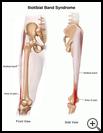
Iliotibial Band Syndrome in the Knee
________________________________________________________________________
KEY POINTS
- Iliotibial band syndrome is swelling, irritation, and pain on the outer side of the leg.
- Treatment may include stretching and exercises, massage, physical therapy, a shot of steroid medicine, or surgery.
- Follow the full course of treatment your healthcare provider prescribes.
________________________________________________________________________
What is iliotibial band syndrome?
Iliotibial band syndrome is swelling, irritation, and pain on the outer side of the knee. The iliotibial band is a layer of tissue on the outside of the thigh. It connects a muscle in your hip to the shinbone in your lower leg.
What is the cause?
The iliotibial band can get irritated from rubbing over the end of the thighbone near the knee or hip. This happens most often from running or cycling.
This problem may happen because you:
- Have a tight iliotibial band
- Have tight muscles in your hip or leg
- Have legs that are not the same length
- Run on sloped surfaces
- Run in shoes with a lot of wear on the outside of the heel
What are the symptoms?
The main symptom is pain on the outer side of the leg.
How is it diagnosed?
Your healthcare provider will examine you and ask about your symptoms, activities, and medical history.
How is it treated?
The pain from iliotibial band syndrome usually goes away in a few weeks with self-care. Your healthcare provider may recommend stretching and exercises to help you recover. You may be instructed to do self massage with a foam roller. Your provider may refer you to physical therapy. In some cases, your provider may give you a shot of steroid medicine.
If rest, physical therapy, and self-care don’t relieve your symptoms after 6 months, your healthcare provider may suggest surgery.
How can I take care of myself?
You may need to change or stop doing the activities that cause pain until the iliotibial band has healed.
To help relieve pain:
- Put an ice pack, gel pack, or package of frozen vegetables wrapped in a cloth on the injured area every 3 to 4 hours for up to 20 minutes at a time.
- Do ice massage. To do this, freeze water in a Styrofoam cup, then peel the top of the cup away to expose the ice. Hold the bottom of the cup and rub the ice over the painful area for 5 to 10 minutes. Do this several times a day while you have pain.
- Take an anti-inflammatory medicine, such as ibuprofen, or other medicine as directed by your provider. Nonsteroidal anti-inflammatory medicines (NSAIDs), such as ibuprofen, may cause stomach bleeding and other problems. These risks increase with age. Read the label and take as directed. Unless recommended by your healthcare provider, you should not take this medicine for more than 10 days.
Special shoes or shoe inserts may help. Talk to your healthcare provider about this.
Follow your healthcare provider's instructions. Ask your provider:
- How long it will take to recover
- If there are activities you should avoid and when you can return to your normal activities
- How to take care of yourself at home
- What symptoms or problems you should watch for and what to do if you have them
Make sure you know when you should come back for a checkup. Keep all appointments for provider visits or tests.
How can I help prevent iliotibial band syndrome?
The best way to prevent this problem is to warm up properly and do stretching exercises before sports or other physical activities.

